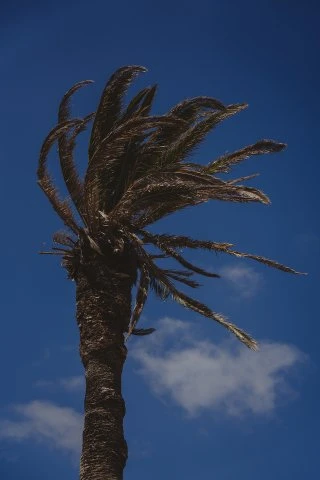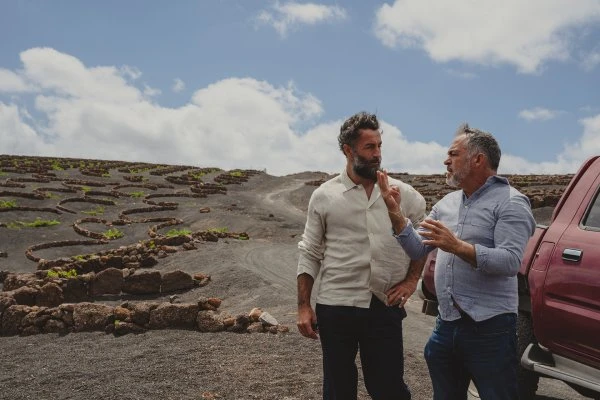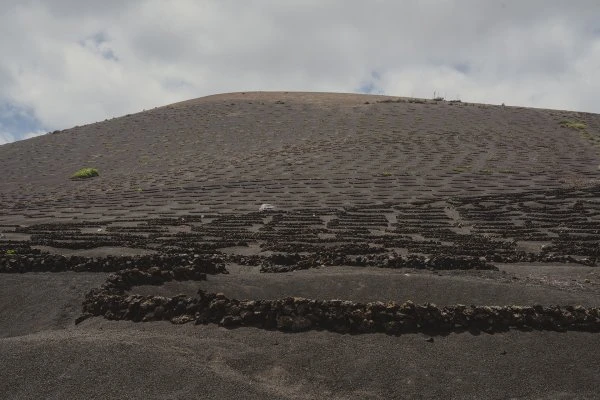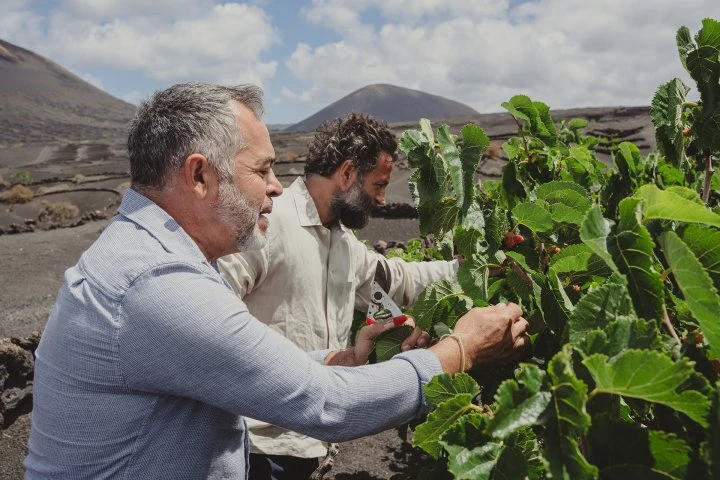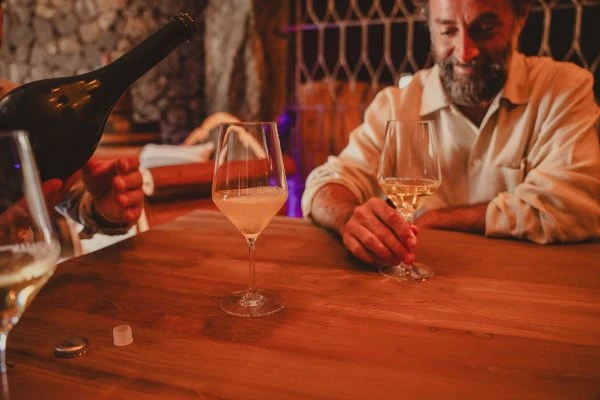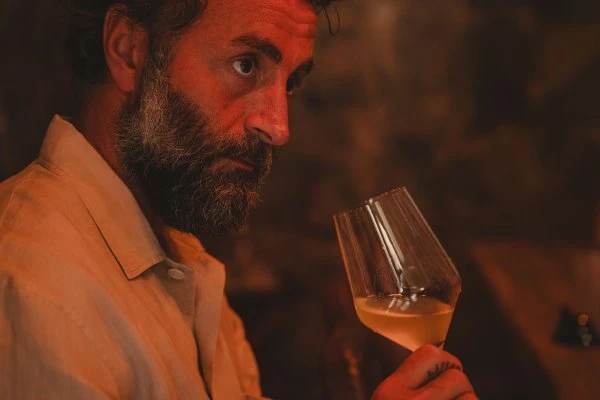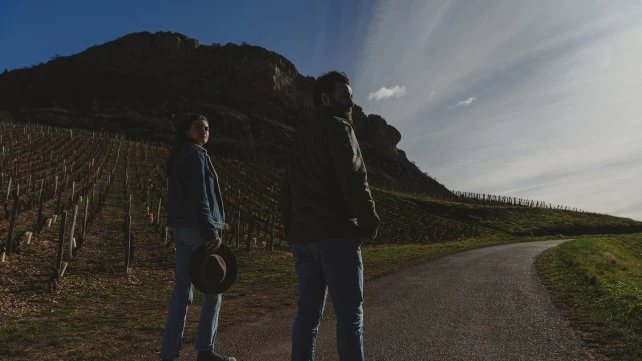
Bodegas Timanfaya
I want to source my grapes only from La Geria and solely from vines over 250 years old.
Alberto González Plasencia, the owner of Bodegas Timanfaya, is a true missionary: he reclaims abandoned vineyards, pruning them back into shape and cleaning them up, he returns them to the production of their former glory days.
The blackness of the lava stone, ash and obsidian. The redness of the rocks. The white of the foaming waves and the little houses dotting the landscape. The green of the cacti. The blue expanse of the sky and the blue of the sea. Lanzarote welcomes us with all the energy of its colours and, in a heartbeat, conquers us forever.
And then, as if wishing to further hold us in its thrall, it offers us the curiously harmonious meeting of volcanic power and design: the almost disproportionate influence with which architect-artist César Manrique seems to have artistically directed the entire island, transforming such a geologically restless place into a peaceful oasis.
This seeming paradox is largely the result of an important revelation: the destructive force of volcanoes, the most recent of which came out of nowhere just 180 years ago, wasn’t such an absolute disaster after all.
Man and nature have succeeded, literally, in rising from their own ashes.
When I think about it, Malvasía Seco could only have been born here and here alone.
Malvasía Seco is the incredible white wine from Bodegas Timanfaya. Treat yourself to the most authentic flavours of Lanzarote now.
During my three days driving along Lanzarote’s smooth roads, I have been captivated by the Island’s charm and its unique sense of isolation from the rest of the world. My burning desire to visit abandoned places with a murky past, cactus gardens, James Bond villain pools and breath-taking views has taken me across the island’s highways and byways, in exploration of this place where nature has always been a somewhat capricious friend.
During Lanzarote’s history, nature first brought the island a year-round, mild climate of warm winters and moderate summers, combined with fertile soil and secluded golden beaches. Then, it submerged whole swathes of the best farmland in a vast tide of merciless lava, swallowing up houses, churches and whole kilometres of unspoilt coastline.
Become an Explorer
Every month we will present an unknown and exclusive winery we have discovered. Every month you will receive what we consider to be its best bottle delivered directly to your door: a wine that is always new, exclusive and surprising. At Christmas, 10% discount.
As I drive towards our meeting point in the car park of Bodega Rubicon, we are accompanied on our way by a soundtrack of Zach Bryan blasting out at full volume. However, we will not be stopping there: far too famous and renowned to be our final destination, we have made it our rendezvous.
For where we're heading, you'd better leave your car here! are the first words Alberto González Plasencia shouts to me from inside his indestructible red pick-up truck.
Amidst squeaks, jolts and a few lost bolts along the way, it takes me a few minutes to realise just who I am sitting next to. Alberto's genuineness, his enthusiasm and his nature, so engaging and empathetic, instantly break down that wall of reverence that his name would otherwise arouse. Indeed, so much so, I barely realise that I am addressing the second best winemaker in all Spain and one of the ten best in the whole world.
As I listen to him, I am captivated and scarcely notice the breeze gently blowing through the pick up's interior; how poetically the hundred-year-old vines stand out on the horizon; how slowly the scenery has changed. It is a feeling of calm, growth and enlightenment that is both unexpected and dazzling.
Alberto doesn't speak perfect English; however, with the freedom to jump into his native Spanish, I am able to follow him and understand when he tells me that Lanzarote is unlike anywhere else in the world. A place that seems, on some level, an impossibility, like a mirage.
He tells me this as he halts the pick-up at one of the highest points of La Geria, thereby enabling me to fully comprehend, admire and contemplate the spectacle unfolding below us.
I brought you up here so that you could see. I want to source my grapes only from La Geria, and solely from vines over 250 years old. - he tells me.
A vast expanse of the blackest black earth, conical holes in the ground, sometimes several metres deep, verdant green vines scattered here and there, encircled by myriads of rough stone crescents, all accompanied by the ever-present gusting of a fierce, hot wind that makes me stagger and sway. And there, looming up in the distance, the great, grim, rusty volcanoes of Timanfaya, which literally exploded in 1730.


Hereabouts, no one has clearer ideas than Alberto. In 1999, his Bodegas Timanfaya project was already on the lips of many and his wine was one of the most renowned in the whole of Spain. However, in 2000, he decided to discontinue it to devote himself to consultancy work at the largest wineries in the Canary Islands. Twenty years on and a fruitful tour of numerous wineries later, Alberto has the necessary expertise to stop going back and forth between the vineyards and wineries of others to focus entirely on his own.
I feel his eyes on me as I cast my gaze over the surrounding vineyards.
This way of growing grapes came about following the great eruption spanning the years 1730 to 1736, and which blanketed the entire area at the foot of the Timanfaya volcano in debris. In order to be able to cultivate in this area again, it was necessary to dig through the layer upon layer of volcanic scree which, in some parts, was more than three metres thick, in order to reach the fertile soil below. Although rain is rare in these parts, it is compensated by the moisture provided by the winds, which infiltrates the earth and is retained by the picón (volcanic ash), preventing it from evaporating. At the moment, we are standing in the very spot where it all began and where the picón naturally occurs: La Geria.
This is exactly why I came to Lanzarote: to see this magnificent territory up close, to touch it, to experience it, to savour it.
Every single vine here is the purest representation of the struggle between life and death: the fluorescent green of the plants against the arid, desolate grey of the earth.
The more I immerse myself in Alberto's work and his story, the more I realise how much of a missionary he really is: he reclaims abandoned vineyards, prunes them into shape, cleans them up and restores them to the production of their former glory days.
Hay vida en todas partes! - "There is life everywhere," he says, almost shouting, as if to shake me from my reveries. He is excited but also angry to see some of the holes completely abandoned, overgrown by wild plants and weeds which are literally stealing moisture from the vines.
Despite this - he continues - the plant will survive! In just two years they can return to producing grapes again.
In the meantime, he photographs them because, he says, even if these craters don't belong to him, he will be back in a couple of days to fix them up: he just can't bear to see them languishing abandoned and uncared for.
This is Alberto Gonzalez. A true fighter.
Look, just look how fertile this land is! - he shouts as he walks among the small craters - In the world a vineyard is considered old if it is 35 years old. The ones around us were planted after the eruption of 1736 which means they’re nigh on 300 years old! Do you have any idea how much genetic information they can give us by having lived so long and without water? You have to take that into account you know!
Lanzarote, incidentally, is the first place I have visited where phylloxera* has never arrived and, as a result, all the vines are free-standing.
*Phylloxera is a deadly insect pest of American origin. It arrived in Europe in the second half of the 19th century and plagued our continent's viticulture and changed the history of vines and winemaking forever..
Listening to him, I can clearly tell just how well-versed Alberto is in the language of this land and how much he embodies its spirit. Defence of native vines, defence of the ecosystem and respect for traditions are the foundations on which he has built his project. I, meanwhile, am looking forward to tasting, for the first time in my life, a wine made from centuries-old vines.


La cantina è nelle ultime fasi della sua costruzione: un altro punto dell’interminabile lista di progetti, idee e visioni di Alberto. Tutto è studiato per raccontare l’anima di questo The winery is in the final stages of its construction: another item on Alberto's endless list of projects, ideas and visions. Everything here is designed to convey the soul of this place and to allow visitors to immerse themselves in the history of the people of the island.
An entire lava flow with ghostly contours runs through the property, as if to further remind us of the link between the land and man’s labours.
Walking barefoot in this place, - says Alberto - fills me with peace and enables me to rebalance myself. Can you feel how much energy and power is released?
In fact, the power of nature here is overwhelming.
And then, it is finally time to taste the Malvasía Seco: I have so been looking forward to.
The labelling on the bottle is both hypnotic and surreal. Made with four different print processes, it is yet further proof of just how connected Alberto is with Lanzarote. Only he could decide to create an embossed relief label using the natural picón of the 1730 eruption. Running your finger over the relief you can feel the island. - he points out, proudly.


Volcanic Malvasía is a grape variety endemic to Lanzarote, following its disappearance from the rest of the Canary Islands. This wine, with a production of just over 3,000 bottles, comes from grapes unique to this island and solely from vines more than 250 years old. Truly intrigued, I taste it.
I would need an entire sheet of blank paper to describe everything I’m experiencing. - are the only words I can say to Alberto.
Gentle aromas of white, tropical fruit, with mineral notes. In the mouth, it is fresh, balanced, full-bodied and soft. Suddenly it explodes with all the force of its terroir. A salty peach, even comes to mind: salinity, such an amazing amount of salinity. You can detect herbs, the earth and the sea and I can actually feel the personality of this wine and the power of the grapes it comes from. I can also sense the hand of Alberto, who follows traditional methods to produce it, without subjecting it to any kind of treatment, stabilization or clarification, always respecting the inherent qualities of the grapes.
Truly remarkable, a panoply of different scents and aromas are revealed with every sip. A veritable evolution in a glass; I feel incredibly privileged to be here tasting and sharing it with such an authentic and passionate person.
Lastly, as I have often found, there also comes the bitter-sweet taste of melancholy. Because when a place becomes like home in a heartbeat, then leaving it is complicated.
However, I have learnt that, among the thousands of memories of each trip, some are indelibly etched deep inside me. And it is these very moments that give me the strength to leave again. Because I know they are safeguarded within me, each and every one, like little memory palaces of happiness ready to re-awaken and vibrate once more. And touching a hundred-year-old vineyard, inside a picón crater, in the company of one of the best oenologists in the world, will be a moment I shall treasure forever.

Subscribe
Every month we will present an unknown and exclusive winery we have discovered. Every month you will receive what we consider to be its best bottle delivered directly to your door: a wine that is always new, exclusive and surprising. At Christmas, 10% discount.










